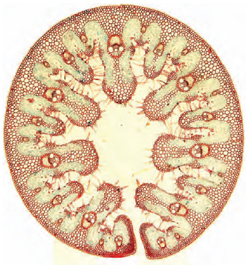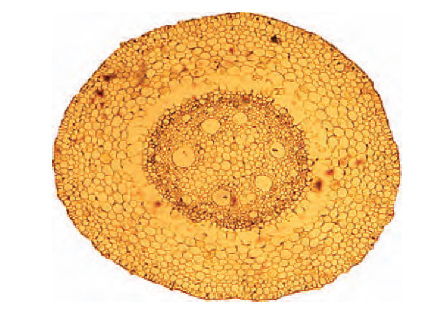Minerals
Content
Essential minerals are those inorganic substances necessary for the plant to grow and develop normally. They can be conveniently divided into two groups. The major nutrients (macronutrients) are required in relatively large quantities whereas the micronutrients (trace elements) are needed in relatively small quantities, usually measured in parts per million, and within a narrow concentration range to avoid Deficiency or toxicity. The list of essential nutrients is given in Table 9.1. Non-essential minerals, such as sodium and chlorine, appear to have a role in the plants but not as a universal requirement for growth and development. Sodium is made use of in many plants, notably those of estuarine origins, but whilst it does not appear to be essential there is an advantage in using agricultural salt on some crops such as beet or carrots. Aluminium plays an important part in the colour of Hydrangea flowers and silicon occurs in many grasses to give them a cutting edge or sharp ridges on their leaves.
Functions and Deficiency symptoms of minerals in the plant Many essential minerals have very specific functions in the plant cell processes. When in short supply (deficient) the plant shows certain characteristic symptoms, but these symptoms tend to indicate an extreme Deficiency. To ensure optimal mineral supplies, growing media analysis or plant tissue analysis can be used to forecast low nutrient levels, which can then be addressed. Nitrogen is a constituent of proteins, nucleic acids and chlorophyll and, as such, is a major requirement for plant growth. Its compounds comprise about 50 per cent of the dry matter of protoplasm, the living substance of plant cells. Deficiency causes slow, spindly growth in all plants and yellowing of the leaves (chlorosis) due to lack of chlorophyll. Stems may be red or purple due to the formation of other pigments. The high mobility of nitrogen in the plant to the younger, active leaves leading to the old leaves showing the symptoms first. Phosphorus is important in the production of nucleic acid and the formation of adenosine triphosphate (see ATP). Large amounts are therefore concentrated in the meristem. Organic phosphates, so vital for the plant’s respiration, are also required in active organs such as roots and fruit, while the seed must store adequate levels for germination. Phosphorus supplies at the seedling stage are critical; the growing root has a high requirement and the plant’s ability to establish itself depends on the roots being able to tap into supplies in the soil before the reserves in the seed are used up. Deficiency symptoms are not very distinctive. Poor establishment of seedlings results from a general reduction in growth of stem and root systems. Sometimes a general darkening of the leaves in dicotyledonous plants leads to brown leaf patches, while a reddish tinge is seen in monocotyledons. In cucumbers grown in deficient peat composts or NFT, characteristic stunting and development of small young leaves leads to brown spotting on older leaves. Potassium. Although present in relatively large amounts in plant cells, this mineral does not have any clear function in the formation of important cell products. It exists as a cation and acts as an osmotic regulator, for example in guard cells, and is involved in resistance to chilling injury, drought and disease. Deficiency results in brown, scorched patches on leaf tips and margins (see Figure 21.4), especially on older leaves, due to the high mobility of potassium towards growing points. Leaves may develop a bronzed appearance and roll inwards and downwards. Magnesium is a constituent of chlorophyll. It is also involved in the activation of some enzymes and in the movement of phosphorus in the plant. Deficiency symptoms appear initially in older leaves because magnesium is mobile in the plant. A characteristic interveinal chlorosis appears (see Figure 21.5), which subsequently become reddened and eventually necrotic (dead) areas develop. Calcium is a major constituent of plant cell walls as calcium pectate, which binds the cells together. It also influences the activity of meristems especially in root tips. Calcium is not mobile in the plant so the Deficiency symptoms tend to appear in the younger tissues first. It causes weakened cell walls, resulting in inward curling, pale young leaves, and sometimes death of the growing point. Specific disorders include ‘topple’ in tulips, when the flower head cannot be supported by the top of the stem, ‘blossom end rot’ in tomato fruit, and ‘bitter pit’ in apple fruit. Sulphur is a vital component of many proteins that includes many important enzymes. It is also involved in the synthesis of chlorophyll. Consequently a Deficiency produces a chlorosis that, due to the relative immobility of sulphur in the plant, shows in younger leaves first. Iron and manganese are involved in the synthesis of chlorophyll; although they do not form part of the molecule they are components of some enzymes required in its synthesis. Deficiencies of both minerals result in leaf chlorosis. The immobility of iron causes the younger leaves to show interveinal chlorosis first. In extreme cases, the growing area turns white. Boron affects various processes, such as the translocation of sugars and the synthesis of gibberellic acid in some seeds (see dormancy). Deficiency causes a breakdown and disorganization of tissues, leading to early death of the growing point. Characteristic disorders include ‘brown heart’ of turnips, and ‘hollow stem’ in brassicas. The leaves may become misshapen, and stems may break. Flowering is often suppressed, while malformed fruit are produced, e.g. ‘corky core’ in apples, and ‘cracked fruit’ of peaches. Copper is a component of a number of enzymes. Deficiency in many species results in dark green leaves, which become twisted and may prematurely wither. Zinc, also involved in enzymes, produces characteristic Deficiency symptoms associated with the poor development of leaves, e.g. ‘ little leaf ’ in citrus and peach, and ‘rosette leaf’ in apples.
Mineral uptake Minerals are absorbed to form the soil solution (see Plant nutrition). The plants take up only water-soluble material so all supplies of nutrients including fertilizers and manures must be in the form of ions (charged particles). The movement of the elements in the form of ions occurs in the direction of root cells containing a higher mineral concentration than the soil, i.e. against a concentration gradient. The passage in the water medium across the root cortex is by simple diffusion, but transport across the endodermis requires a supply of energy from the root cortex. The process is therefore related to temperature and oxygen supply (see respiration). Nutrients are taken up predominantly by the extensive network of fine roots that grow in the top layers of the soil (see Figure 9.1). Damage to the roots near the soil surface by cultivations should be avoided because it can significantly reduce the plant’s ability to extract nutrients. It is recommended that care should be taken to ensure that trees and shrubs are planted so their roots are not buried too deeply and many advocate that the horizontally growing roots should be set virtually at the surface to give the best conditions for establishment. The surface thickening that occurs in the ageing root does not significantly reduce the absorption ability of most minerals, e.g. potassium and phosphate, but calcium is found to be principally taken up by the young roots. |
||||||||||||||||||







